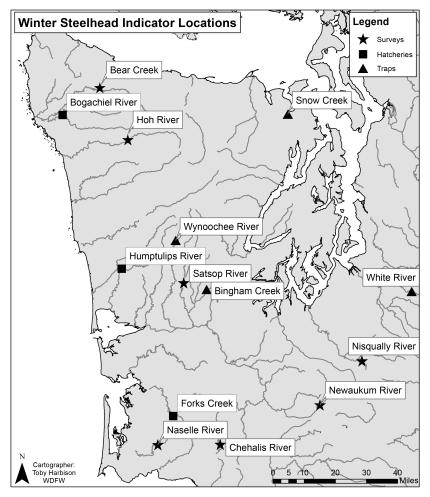
As a pilot program, this page provides the public with in-season updates of adult steelhead and/or redd counts at select locations across the Washington Department of Fish and Wildlife (WDFW) Coastal Region 6 and is updated every few weeks during the winter steelhead season. The indicator locations included do not represent an exhaustive list of redd survey, trap count, and hatchery count locations.
Trap counts and hatchery counts communicate the number of adult wild and/or hatchery origin steelhead returning to each indicator location following migration. Redd counts reflect the number of nests that female steelhead dig when they lay eggs. Scientific technicians and biologists collect redd counts by foot, boat, and/or helicopter during spawning ground surveys, which are conducted every 7 to 14 days from February into June.
In-season steelhead population data helps WDFW monitor trends in steelhead abundance, spawn timing, location, and reproductive capacity, among other factors. Therefore, WDFW fisheries managers are leading an effort to increase steelhead monitoring across the region.
Note: This pilot program represents one in a suite of tools fishery managers use to monitor and manage fisheries. All data presented should be considered tentative. Data collected by tribal comanagers are not included in these figures.
To learn more about tribal co-management, visit the WDFW salmon and steelhead management page. To share feedback, please visit our WDFW Coastal Steelhead Management page.
Grays Harbor
Chehalis wild redd counts
These counts represent three of the 42 of index reaches that WDFW surveys annually within the Chehalis basin.
Wynoochee trap wild counts
Tacoma Power operates the Wynoochee trap from early September through late June annually. WDFW fisheries biologists and Tacoma Power staff check the trap twice a week. WDFW fisheries managers either use wild steelhead from the trap to support hatchery production for wild genetic integration, return them to the river below the trap, or transport them above the lower dam to support habitat in the 2.5 miles of between the main dam and the lower dam.
Bingham Creek Trap
Humptulips Hatchery counts
Note: Humptulips hatchery steelhead return early in the season.
Wynoochee trap hatchery counts
Fishery managers either use hatchery steelhead that they encounter in the trap in hatchery production or transport them upstream of the reservoir.
Willapa
Naselle River wild redd count
Forks Creek Hatchery (trap) counts
Note: Forks Creek hatchery steelhead return early in the season.
Olympic Peninsula
Hoh wild winter-run steelhead redd counts
In collaboration with the Hoh Tribe and Olympic National Park, WDFW fish biologists conduct steelhead spawning ground surveys throughout the Hoh watershed. Data reflects a 3.5-mile section of the mainstem Hoh from the mouth of Twin Creek to the Ranger Station (river mile 32.1 to 35.6). This section has routinely good visibility and a relatively high redd concentrations.
Quillayute wild winter-run steelhead redd counts
In collaboration with the Quileute Tribe and Olympic National Park, WDFW fish biologists survey steelhead throughout the Quillayute watershed. Bear Creek is a tributary to the Sol Duc, entering the Sol Duc River about 5.5 miles above the Sol Duc Hatchery at river mile 35.3. WDFW conducts foot surveys over 6 miles of Bear Creek with surveys occurring about every two weeks (conditions permitting).
Bogachiel Hatchery early winter steelhead counts
Bogachiel Hatchery winter steelhead return early in the season.
Strait of Juan de Fuca
Snow Creek trap counts
WDFW operates a full-spanning weir at Snow Creek, a tributary to Discovery Bay. Operating since 1977, it supports one of the longest running datasets on wild steelhead in the Puget Sound Evolutionarily Significant Units (ESU) and represents one of the best early indicators for monitoring steelhead returns to Hood Canal.
South Puget Sound
Nisqually River wild redd count
White River Trap Counts
White River trap is part of the Buckley Diversion Dam located at river mile 24.3 and is owned and operated by the Army Corps of Engineers. Fish within the trap are sampled and enumerated by the Puyallup and Muckleshoot tribes. Fish not used for hatchery production are transported upstream of the Mud Mountain Dam by the Army Corps of Engineers.